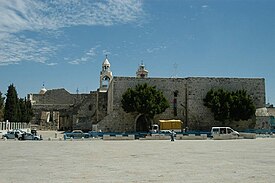Son of God (TV series)
In the United States, the series was shown on the Discovery Channel under the name Jesus: The Complete Story as a single three-hour programme, two weeks after its UK broadcast.
[8] In the US version of Son of God, which was broadcast on the Discovery Channel and retitled Jesus: The Complete Story,[10] the footage of Bowen was edited out and his narration was redubbed by American actor Avery Brooks.
[15] Whitbourn subsequently used the seminal themes from his orchestral score as the basis of his popular choral work, Son of God Mass, for soprano saxophone, choir and organ.
Computer graphic images were created by design group Red Vision,[16] who employed techniques similar to ones used in the 2000 BBC series Walking with Dinosaurs.
[18] Promotional campaigns for both the British and American broadcasts of the series focused on the technology and science being used in the programme, and the special effects that Red Vision had created.
[9] Locations from Jesus's time—such as Caesarea, Yatta and Sepphoris—were recreated by archaeologists using evidence from buildings and street plans, and were then digitised into computer graphics by Red Vision.
[e 1] He cites the Romano-Jewish historian Josephus as one of 80 sources that confirms that Jesus existed and that describes him as "a wise man who did surprising feats, ... won over followers from among Jews and Greeks, ... was accused by the Jewish leaders, [and] was condemned to be crucified by Pilate".
[27] Bowen interviews James H. Charlesworth from Princeton University about the discovery of the Dead Sea Scrolls in 1947, then travels to Bethlehem to visit the Church of the Nativity, a structure built over a series of first-century caves and grottos.
[23][28] Joe Zias, an archaeologist from the Hebrew University of Jerusalem confirms this, saying that the Greek word "katalyma" is usually translated into English as "upper room" rather than "inn".
Hanan Eshel, an archaeologist from Bar-Ilan University, proposes that Jesus's interest in religion and politics might have been sparked off during a family visit to the Temple Mount, the "headquarters of the Jewish faith".
Jesus met and ate with sinners, the disabled and prostitutes, and fulfilled Old Testament prophecy by riding into the Temple Mount through the Golden Gate on a donkey at Passover.
As guest of honour, Jesus would have been at the end of the table with John the Apostle at his side, rather than at the centre, as proposed by more familiar depictions such as Leonardo da Vinci's The Last Supper.
Leaving the Middle East for the first time, he travels to New York City and meets with Frederick Zugibe, a forensic pathologist at Columbia University.
[31] Zugibe experiments on volunteers in Rutland County, Vermont, by measuring their blood pressure while they are strapped to crosses with their arms outstretched and level with their shoulders.
[32] William Klassen, an historian at École Biblique in Jerusalem, theorises that the Greek word "paradidomi" was mistranslated, and that Judas simply "handed over" Jesus to the Romans, rather than betrayed him.
[35]"[Son of God] turned out to be worthy of all [its] publicity, as the stunning graphics that recreated Jesus's face were used to bring his life to gritty reality – somewhat removed from Biblical views of Christ."
[25] The graphics created by Red Vision were well received: The Daily Record described the computer imagery as stunning,[26] while Gareth McLean of The Guardian noted that the series was "visually, ... quite a treat".
[36] A review of a more critical nature came from Catherine Bennett, also writing for The Guardian, who questioned the facial reconstruction from the third episode and suggested that it was dismissive to imply that it was how Jesus truly appeared.
[37] Speaking about the study, Bennett remarked: "We must hope that ... future BBC controllers do not dig up, say, Robin Cook's skull, drape it in Plasticine, and ask: 'Is this the real face of Tony Blair?'".
[24] The programme received criticism from theological scholars: following the broadcast of the first episode, Tom Wright, one of two consultants used during production of the series, felt that Jesus's mission had been misrepresented by the show.
Writing for The Orlando Sentinel, Hal Boedeker agreed that the computer imaging was spectacular, but that the rest of the show was a "hodgepodge" that "[went] off on some strange tangents".
[32] Eric Mink of The Daily News stated that the show relied too heavily on exaggeration and that it was "sloppy with facts",[41] while Ann Rodgers-Melnick of the Pittsburgh Post-Gazette described it as "uneven but vivid".
[42]The first episode of Son of God shown in the UK gained six million viewers and an audience share of 25%, which was considered high for a religious documentary.
[46] In the United States, the show was aired by the Discovery Channel under the name Jesus: The Complete Story, as a single three-hour special at 8 p.m. on 15 April, two weeks after its UK broadcast.
